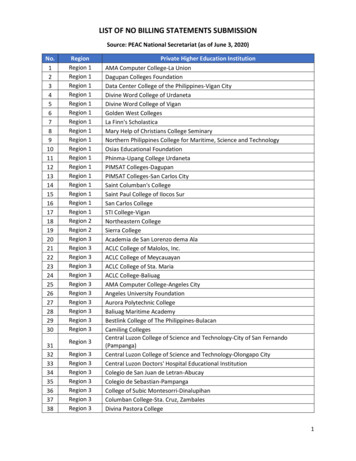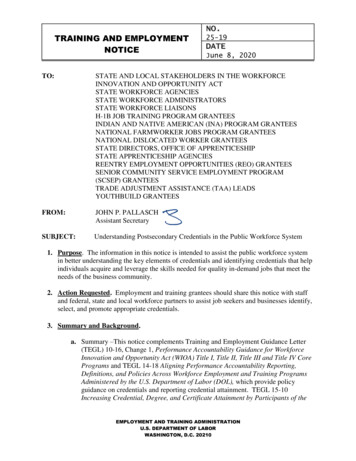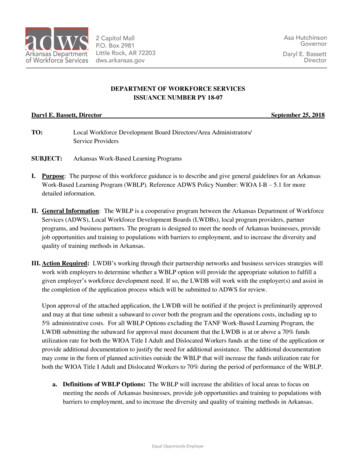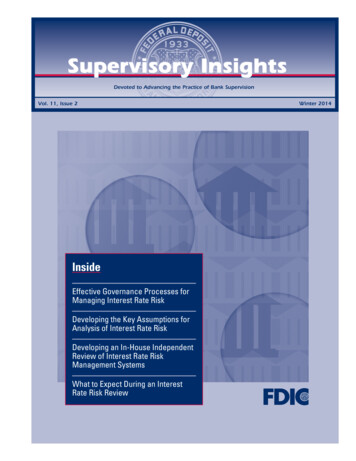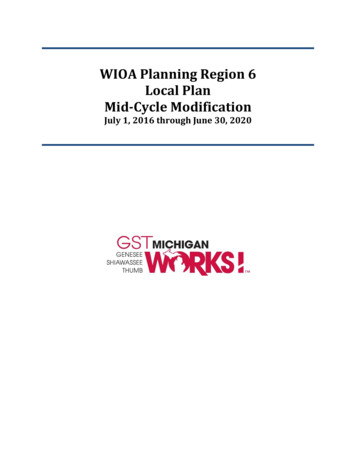
Transcription
WIOA Planning Region 6Local PlanMid-Cycle ModificationJuly 1, 2016 through June 30, 2020
Attachment BApproval Request Form1. MWA Name and Number:GST Michigan Works!132. Plan Title(s): WIOA Local Plan for Program Years 2016 thru 20193. Policy Issuance Number: 16-02 Change 14. Plan Period: 7/1/16-6/30/20The Chief Elected Official(s) and Workforce Development Board hereby request approval ofthis document. Please insert the printed name for each signature provided below.Signature of Authorized Chief Elected OfficialDate:Printed Name: Cheryl ClarkSignature of Workforce Development Board ChairpersonDate:Printed Name: Leanne PandurenThe Michigan Talent Investment Agency/Workforce Development Agency, in compliancewith applicable federal and state laws, does not discriminate in employment or in theprovision of services based on race, color, religion, sex, national origin, age, disability, height,weight, genetic information, marital status, arrest without conviction, political affiliation orbelief, and for beneficiaries only, citizenship or participation in any federally assistedprogram or activity.
SECTION IILOCAL PLAN REQUIREMENTSLocal plans serve as four-year action plans to develop, align, and integrate service deliverystrategies and to support the state’s vision and strategic and operational goals. The local plansets forth the strategy to: Direct investments in economic, education, and workforce training programs tofocus on providing relevant education and training to ensure that individuals,including youth and individuals with barriers to employment, have the skills tocompete in the job market and that employers have a ready supply of skilledworkers. Apply job-driven strategies in the One-Stop system. Enable economic, education, and workforce partners to build a skilled workforcethrough innovation in, and alignment of, employment, training, and educationprograms. Incorporate the local plan in to the regional plan per 20 Code of FederalRegulations (CFR) 679.540.Section 108(b) (1) through (22) of the WIOA requires local boards and CEOs to develop andsubmit a comprehensive four-year local plan that is consistent with the State Plan and based onan analysis of regional labor market data. The local plan shall include:1. An analysis of regional labor market data and economic conditions including:The regional analysis prepared as part of the regional plan. (See Section I, #2)All of the following data and analysis is representative of WIOA Planning Region 6, whichconsists of Genesee, Huron, Lapeer, Sanilac, Shiawassee, and Tuscola counties.Core Partner InvolvementTo ensure an accurate analysis of regional labor market data economic conditions, the Region 6planning partners engaged core partners during all phases of the process. MWA leadershipidentified the following core partners representing WIOA Titles I – IV programs: Title I: Job Corps, YouthBuild and Migrant Seasonal FarmworkersTitle II: Local and intermediate school districts and literacy programsTitle III: MWA contracted service providersTitle IV: MI Rehabilitation Services and MI Bureau of Services for Blind PersonsDuring the initial planning phase, core partners were sent e-mails asking them to identifyavailable data to help understand the nature and special needs of populations served, and to2
provide input on the strengths and weaknesses of workforce development activities and theregion’s capacity to provide their respective populations with workforce services. The surveyquestions and responses can be found in the Part II: Workforce Development Activities section.When the draft regional plan was made available for public comment, core partners were notifiedand encouraged to make comments on their organizations’ behalf. During the initial publiccomment phase, no formal comments were made.Employment NeedsThe knowledge and skills necessary to meet the employment needs of the employers in the region,including employment needs in in-demand industry sectors and occupations.Existing In-Demand OccupationsThe below occupations not only display high real-time demand today, but are also projected tocontinue to grow in the short run (through 2020). Most offer a relatively high wage.Figure 1: Region 6’s Top 12 Existing/Currently In-Demand OccupationsSOCDescriptionPostings Q220172018 Jobs2020 Jobs2018 - 2020ChangeAnnualOpeningsMedian HourlyEarningsTypical Entry LevelEducation29-1141Registered Nurses3945,4465,549103325 33.92 Bachelor's degree53-3032Heavy and Tractor-Trailer Truck Drivers2182,5932,66168311 -9071First-Line Supervisors of Retail SalesWorkersMaintenance and Repair Workers,GeneralPostsecondarynondegree awardHigh school diploma 18.28or equivalentHigh school diploma 14.57or equivalent11-9199Medical and Health Services Managers586987101260 44.59 Bachelor's degree37-3011Landscaping and GroundskeepingWorkers861,7131,78168239No formal 11.40 educationalcredential43-1011First-Line Supervisors of Office andAdministrative Support Workers531,6491,69344184 23.5331-1014Nursing Assistants602,7182,77355332 13.2743-4051Customer Service Representatives463,4213,5098847841-2031Retail Salespersons1597,2477,28942106247-1011First-Line Supervisors of ConstructionTrades and Extraction Workers474644781452 27.63High school diplomaor equivalent21-1093Social and Human Service Assistants895575691272 11.46High school diplomaor equivalentHigh school diplomaor equivalentPostsecondarynondegree awardHigh school diploma 14.21or equivalentNo formal 9.74 educationalcredentialSource: Bureau of Labor Statistics, Economic Modeling Specialists, Intl (EMSI), Help WantedOnline (HWOL)Page 3
These are occupations that display a high level of real-time job postings online. All areprojected to grow in the short-term (through 2020), and about half offer a wage abovethe state median, 17.62.Two of the current most in-demand occupations in Region 6 require advanced levels ofeducation, such as a bachelor’s degree, while the rest present growing opportunities forthose with shorter-term training. The hourly pay range is between 9.74 for RetailSalespersons to 44.59 for Medical and Health Services Managers (Figure 1).Emerging In-Demand OccupationsFigure 2 presents occupations that are projected to record solid job expansion over the longerterm (until 2028); factors such as high annual job openings and an above average wage were alsoconsidered (Figure 2).4
Figure 2: Region 6’s Top 25 Emerging/Future In-demand OccupationsTypical EntryLevel Education41-4011Sales Representatives, Wholesale andManufacturing, Technical andScientific Products16922131.0%25 38.27 Bachelor's degree29-1051Pharmacists66575514.0%40 56.5315-1132Software Developers, Applications29836823.0%28 36.63 Bachelor's degree15-1121Computer Systems Analysts25932626.0%25 36.13 Bachelor's degree11-3021Computer and Information SystemsManagers22126520.0%22 43.94 Bachelor's degree11-1021General and Operations Managers2,4932,73710.0%234 44.03 Bachelor's degree13-1111Management Analysts54261614.0%56 35.21 Bachelor's degree29-1171Nurse Practitioners19623922.0%15 46.5411-2021Marketing Managers11014027.0%14 47.36 Bachelor's degree11415032.0%12 43.61 Bachelor's degree26230015.0%19 52.859913637.0%11 38.58 Bachelor's degree39443510.0%39 44.83 Bachelor's degree32442531.0%46 22.78 Bachelor's degree52766727.0%77 s Engineers, ExceptComputerPhysician AssistantsSoftware Developers, SystemsSoftwareSales ManagersMarket Research Analysts andMarketing SpecialistsTelecommunications EquipmentInstallers and Repairers, Except LineInstallers2028 JobsMedianHourlyEarningsDescription17-20722018 Jobs2018 - 2028 Annual% Change OpeningsSOCDoctoral orprofessionaldegreeMaster's degreeMaster's degreePostsecondarynondegree awardHigh schooldiploma orequivalentMaster's degreeHigh schooldiploma orequivalentHigh schooldiploma orequivalent49-9051Electrical Power-Line Installers andRepairers27131416.0%28 32.0825-9031Instructional Coordinators16020528.0%21 28.3749-9041Industrial Machinery Mechanics8951,05718.0%99 23.3941-3099Sales Representatives, Services, AllOther84299919.0%125 22.6811-9199Managers, All Other32836311.0%27 44.25 Bachelor's degree29-1123Physical Therapists39744111.0%21 39.3229-1141Registered Nurses5,4465,8217.0%319 33.92 Bachelor's degree13-1199Business Operations Specialists, AllOther9071,02513.0%98 26.12 Bachelor's degree11-3031Financial Managers5736147.0%47 48.72 Bachelor's degree13-1151Training and Development Specialists16420827.0%22 25.58 Bachelor's degreeSource: Economic Modeling Specialists, Intl (EMSI)5Doctoral orprofessionaldegree
These are occupations that display promising growth in the long term (through 2028),have high annual openings, and pay over 20 hourly.A majority of the emerging occupations in WIOA Planning Region 6 require advancedlevels of education, contrasting the current top occupations. All but four require at leasta bachelor’s, while five require either a Master’s or Doctoral degree. The hourly pay rangeis between 22.37 for Telecommunications Equipment Installers and Repairers and 56.53 for Pharmacists (Figure 2).In-Demand Middle Skills Occupations Figure 3 represents occupations that show high real-time demand, provide a “livable”wage over 15 per hour, and require training or education beyond high school but lessthan a bachelor’s. While most of the emerging in-demand occupations generally requirea bachelor’s or higher education, many WIOA Planning Region 6 MWA customers seekshorter term education or training to find work. Figure 3 provides a snapshot of themiddle skills occupations available in Region 6.6
Figure 3: Region 6’s Top 25 Currently In-Demand Middle Skills OccupationsSOC2018JobsDescription2028Jobs2018 - 2028 2018 - 2028 AnnualChange% Change ons EquipmentInstallers and Repairers, Except LineInstallers52766714027%77 22.3749-9041Industrial Machinery Mechanics8951,05716218%99 23.3984299915719%125 22.682713144316%28 32.089631,029667%109 31.1941-309949-9051Sales Representatives, Services, AllOtherElectrical Power-Line Installers andRepairers47-2152Plumbers, Pipefitters, and Steamfitters47-2111Electricians1,0671,146797%129 28.5129-2061Licensed Practical and LicensedVocational Nurses8769729611%75 23.2533-3012Correctional Officers and Jailers5656195410%53 25.251101382825%15 22.602262563013%31 24.04Typical Entry LevelEducationPostsecondarynondegree awardModerate-term onthe-job trainingHigh school diploma orequivalentHigh school diploma orequivalentHigh school diploma orequivalentHigh school diploma orequivalentHigh school diploma orequivalentPostsecondarynondegree awardHigh school diploma orequivalentHigh school diploma orequivalentAssociate's degreeHigh school diploma orequivalentAssociate's degreeLong-term on-thejob trainingModerate-term onthe-job trainingLong-term on-thejob training31-2021Mobile Heavy Equipment Mechanics,Except EnginesPhysical Therapist Assistants47-4041Hazardous Materials Removal Workers73942129%12 23.8429-2032Diagnostic Medical SonographersSales Representatives, Wholesale andManufacturing, Except Technical andScientific ProductsWeb Developers1781992112%12 29.992,4142,5331195%262 24.45951182324%10 23.11 Associate's degree49-9021Heating, Air Conditioning, andRefrigeration Mechanics and Installers4064544812%46 20.7815-1152Computer Network Support Specialists2993343512%26 22.40 Associate's degree43-5061Production, Planning, and ExpeditingClerks2292683917%29 20.1153-2012Commercial Pilots1625956%3 36.563333915817%38 18.79401433328%48 22.9512%43 20.6249-304241-401215-113449-303147-2073Bus and Truck Mechanics and DieselEngine SpecialistsOperating Engineers and OtherConstruction Equipment OperatorsTypical Moderate-term onthe-job trainingLong-term on-thejob trainingNoneModerate-term onthe-job trainingNoneHigh school diploma or Moderate-term onequivalentthe-job trainingPostsecondarynondegree awardNoneLong-term on-thejob trainingNoneHigh school diploma orequivalentHigh school diploma orequivalentHigh school diploma orequivalentHigh school diploma orequivalentHigh school diploma orequivalentAssociate's degreeHigh school diploma orequivalentModerate-term onthe-job trainingModerate-term onthe-job trainingLong-term on-thejob trainingModerate-term onthe-job trainingShort-term on-thejob trainingNoneModerate-term onthe-job training37-3013Tree Trimmers and Pruners3153523729-2021Dental Hygienists623645224%41 28.5247-2211Sheet Metal Workers75881317%10 24.8562781626%9 21.82Postsecondarynondegree award67993248%11 18.61High school diploma or Long-term on-theequivalentjob training51-401249-9052Computer Numerically ControlledMachine Tool Programmers, Metal andPlasticTelecommunications Line Installers andRepairersApprenticeshipSource: Economic Modeling Specialists, Intl (EMSI) Besides the inherent educational specifications, the criteria used were a combination ofprojected growth (numeric and percent) above the all-occupation average, numerousannual openings, and an above-average hourly wage.7
Knowledge, Skills, and Abilities Needed in In-Demand Industries and OccupationsThe next section presents an analysis of the knowledge, skills, and abilities needed in theseoccupations. The tools and technologies as well as the required certifications are presentedwhere available.Healthcare Practitioner and Technical OccupationsKnowledge, Skills, and AbilitiesKnowledge of the information and techniques needed to diagnose and treat human injuries anddiseases are important in all critical health care occupations. This includes knowledge ofsymptoms, treatment alternatives, drug properties and interactions, and preventive health caremeasures.KnowledgeMedicine and DentistryBiologyCustomer and Personal ServiceEnglish LanguagePsychologySkillsActive ListeningReading ComprehensionSpeakingCritical ThinkingMonitoringAbilitiesProblem SensitivityOral ComprehensionOral ExpressionDeductive ReasoningInductive ReasoningTools, Technologies, and Certifications Tools and technologies related to Healthcare occupations include several that ensurequality in the delivery of health services as well as increasing efficiencies in delivery ofcare, such as electronic medical records and time management. There are many certifications in healthcare occupations as many careers involvelicensure. Beyond occupational-specific requirements, important certifications areconcentrated in particular areas of patient care.Tools and TechnologiesQuality AssurancePatient Electronic Medical RecordsMicrosoft OfficeTime ManagementQuality ControlCertificationsBasic Life SupportCertification in Cardiopulmonary ResuscitationAdvanced Cardiac Life SupportPediatric Advanced Life SupportNurse AdministrationInformation Technology OccupationsKnowledge, Skills, and Abilities These positions require an important mix of technical, business, and problem-solvingskills. Information technology jobs require knowledge of circuit boards, processors, chips,electronic equipment, and computer hardware and software, including applications andprogramming. Design and systems analysis skills are also vital.8
Abilities for these occupations are typically related to computer usage and programming.For example, job seekers should have the ability for mathematical reasoning, numberfacility, and deductive reasoning.KnowledgeComputer and ElectronicsCustomer and Personal ServiceMathematicsEnglish LanguageDesignSkillsActive LearningReading ComprehensionComplex Problem SolvingCritical ThinkingTroubleshootingAbilitiesMathematical ReasoningNumber FacilityOral ComprehensionProblem SensitivityDeductive ReasoningTools, Technologies, and Certifications Computer occupations have a number of technologies associated with them. Dependingon the occupation, individuals employed in these occupations will need to knoweverything from traditional software packages to advanced computer programminglanguages, like Structured Query Language (SQL), Java, and Linux. Similarly, there are numerous certifications associated with computer occupations. Often,certifications are specific to some software package or technology, like the Cisco NetworkAssociate certification. In other instances, certifications are more general, like ProjectManagement Professional. These and other certifications for Information Technologyoccupations are listed below.Tools and TechnologiesStructured Query Language (SQL)Project ManagementInformationSoftware developmentOracle JavaOther programming languagesCertificationsWeb ServicesTop Secret Sensitive CompartmentedProject Management Professional (PMP)Certified Information SystemsCisco Network Associate (CCNA)Construction and Extraction OccupationsKnowledge, Skills, and Abilities These occupations require workers to perform tasks involving physical labor atconstruction sites. Many workers operate hand and power tools of all types: from airhammers to measuring equipment.KnowledgeMechanicalBuilding and ConstructionDesignSkillsCritical ThinkingActive ListeningJudgement & Decision-making9AbilitiesArm-Hand SteadinessNear VisionProblem Sensitivity
MathematicsEnglish LanguageTime ManagementSpeakingMulti-Limb CoordinationOral ComprehensionTools and TechnologiesTools and TechnologiesLevelsPower saws/grindersCAD softwareWrenches/Hammers/ScrewdriversPersonnel LiftInstallation, Maintenance, and Repair OccupationsKnowledge, Skills, and Abilities Occupations found in this category will require workers to possess skills such as repairing,critical thinking, and troubleshooting. These workers must also be able to maintaincooperative relationships with customers and also possess knowledge about specializedsectors like telecommunications and general public safety and security laws.KnowledgeMechanicalTelecommunicationsCustomer and Personal ServicePublic Safety and SecurityEnglish LanguageSkillsRepairingCritical ThinkingOperation MonitoringTroubleshootingEquipment MaintenanceAbilitiesNear VisionManual/Finger DexterityProblem SensitivityArm-Hand SteadinessDeductive ReasoningTools and TechnologiesTools and TechnologiesLevelsBlow TorchSpecialty Wrenches/ScrewdriversDrill press or radial drillCAM softwareBusiness and Financial OccupationsKnowledge, Skills, and Abilities Occupations found in this category will require workers to possess skills such ascommunication, critical thinking, and time management. These workers must also be ableto establish and maintain cooperative working relationships with others and haveknowledge of economic and accounting principles and practices, the financial markets,banking and the analysis and reporting of financial data.10
KnowledgeMathematicsEconomics and AccountingCustomer and Personal ServiceEnglish LanguagePersonal and Human ResourcesSkillsSpeakingActive ListeningCritical ThinkingJudgment & Decision MakingReading ComprehensionAbilitiesOral ComprehensionWritten ComprehensionProblem SensitivityDeductive ReasoningInformation OrderingTools, Technologies, and Certifications Most of the occupations in this category will need to use office productivity software likeMicrosoft Office for documents, spreadsheets, publications, and databaseadministration. In addition to productivity software, many tools and technologies for business andfinancial occupations involve risk management and even technical proficiencies likeGenerally Accepted Accounting Principles. A large number of certifications in this area are occupation specific, like Certified PublicAccountant (CPA) and Series 7, which allow an individual to practice their trade inconformity with state and federal licensure requirements.Tools and TechnologiesMicrosoft OfficeBusiness developmentRisk ManagementProject management(Series 7)Generally Accepted Accounting PrinciplesCertificationsCertified Public Accountant (CPA)Financial Industry Regulatory Authority (FIRA)Certified Internal Auditor (CIA)General Securities Representative ExamChartered Financial Analyst (CFA)Management and Supervisory OccupationsKnowledge, Skills, and AbilitiesOccupations found in this category will require workers to possess skills such as speaking, activelistening, and critical thinking. Workers must also have knowledge of administration andmanagement and of personnel and human resources. These workers ought to have the ability toexpress and comprehend oral and written communication.KnowledgeAdministration & ManagementCustomer and Personal ServiceEnglish LanguagePersonnel & Human ResourcesMathematicsSkillsSpeakingActive ListeningCritical ThinkingReading ComprehensionCoordination11AbilitiesOral ExpressionOral ComprehensionWritten ComprehensionProblem SensitivityWritten Expression
Tools and TechnologiesTools and TechnologiesSpreadsheet softwarePersonal computersElectronic mail softwareWord processing softwareNotebook computersEducation and Training Alignment with Industries and OccupationsInformation regarding the employment needs of employers, including how education and trainingalign with targeted industries and occupations.A close look at the WIOA Planning Region 6 existing and emerging high-demand, high-wageoccupations reveals that these positions are concentrated in a handful of categories including:Healthcare Practitioners and Technical, Information Technology, Construction and Extraction,Installation, Maintenance, and Repair, Businesses and Financial, and Management occupations.Moreover, four of the top 12 existing in-demand, high-wage occupations in WIOA PlanningRegion 6 require some form of education or training beyond a High School Diploma or equivalent.Figure 4 shows the number of programs available in WIOA Planning Region 6 for each of the top15 existing in-demand occupations.The education and training availability consists of programs reported to the IntegratedPostsecondary Education Data Systems (IPEDS). While a good indicator of the number ofprograms available in a region, some proprietary trainings or private institutions may not becaptured.Note: The data below does not necessarily encompass all of the education and trainingopportunities for each occupation in WIOA Planning Region 6. Rather, it provides a snapshotbased on the data available within IPEDS. Therefore, some private and other proprietaryinstitutions may not be included.12
Figure 4: Education Opportunities for the Top 15 Existing In-Demand Occupations in Region 6SOCDescriptionPostingsQ2 20172018Jobs2020 Jobs2018 - 2020 Annual% Change OpeningsMedianHourlyEarningsTypical Entry LevelEducationProgramsAvailable29-1141Registered Nurses3945,4465,5492%325 33.92Bachelor's degree1 Certificate3 Associate's4 Bachelor's1 Master's1 Doctorate53-3032Heavy and Tractor-Trailer Truck Drivers2182,5932,6613%311 17.24Postsecondarynonndegree award1 Certificate1 Associates41-1011First-Line Supervisors of Retail SalesWorkers1731,8701,8961%210 18.28High school diploma orequivalent1 Certificate1 Bachelor's1 Master's49-9071Maintenance and Repair Workers,General1152,0382,0601%207 14.57High school diploma orequivalentNo programs1 Certificate3 Associate'sBachelor's degree6 Bachelor's 2Master's11-9111Medical and Health Services Managers586987102%60 44.5937-3011Landscaping and GroundskeepingWorkers861,7131,7814%239 11.40No formal educationalcredentialNo programs43-1011First-Line Supervisors of Office andAdministrative Support Workers531,6491,6933%184 23.53High school diploma orequivalent2 Certificates1 Associate's2 Bachelor's31-1014Nursing Assistants602,7182,7732%332 13.27Postsecondarynondegree award1 Certificate1 Bachelor's43-4051Customer Service Representatives463,4213,5093%478 14.21High school diploma orequivalentNo programs41-2031Retail Salespersons1597,2477,2891%1,062 9.74No formal educationalcredential1 Associate's47-1011First-Line Supervisors of ConstructionTrades and Extraction Workers474644783%52 27.63High school diploma orequivalent2 Certificates21-1093Social and Human Service Assistants895575692%72 11.46High school diploma orequivalent1 Certificate1 Associate's1 Bachelor's31-9092Medical Assistants561,4321,4632%169 13.58Postsecondarynondegree award10 Certificates6 Associate's1 Bachelor's35-1012First-Line Supervisors of FoodPreparation and Serving Workers751,6561,6490%233 13.70High school diploma orequivalent2 Associate's1 Bachelor's43-5081Stock Clerks and Order Fillers573,3513,3500%431 9.78High school diploma orequivalentNo programsSource: Integrated Post-Secondary Data System (IPEDS), EMSI, HWOL13
Workforce AnalysisAn analysis of the current workforce in the region, including employment/ unemployment data,labor market trends, and the educational and skill levels of the workforce, including individualswith barriers to employment.WIOA Planning Region 6 does not have uniform educational attainment across its diversecounties. The City of Flint and Sanilac county have the lowest levels, with 11.2 percent and 13.1percent of residents holding a bachelor’s degree or higher, respectively. Compared to the stateaverage of 27.4 percent, these levels are very low. All of the region’s counties have a lower rateof college degrees than the state average. The highest educational attainment in the region is inGenesee county, where 19.9 percent of the adult residents have a bachelor’s degree or higher,still seven percentage points below the average. This represents a major opportunity to improveworker preparation for increasingly high-skilled in-demand jobs.Figure 5: Educational lint CityPopulation 25 years and overHigh school graduate or higher,number of persons, age 25years , 2012-2016High school graduate or higher,percent of persons, age 25years , 2012-2016Bachelor's degree or higher,number of persons, age 25years , 2012-2016Bachelor's degree or higher,percent of persons, age 25years , 2012-2016SanilacShiawassee TuscolaCountyCountyCounty29,27847,519 38,124State ofMichigan6,682,881Source: 2012-2016 ACS Five-Year EstimatesLabor force participation rate estimates show that Shiawassee county has closest to the stateaverage rate, with 59.0 percent compared to Michigan’s 61.2 percent. The City of Flint, however,is ten percentage points below the state average. Figure 6 displays these values. These rates havebeen consistently declining, with fewer individuals of working age participating in the labor forceover time. This is not a phenomenon unique to Michigan; much of the United State is seeing thesame drop in labor force participation. However, the issue is exacerbated in Michigan due to anaging workforce and slow population growth.14
Figure 6: Labor Force seeCounty55,643TuscolaCounty44,003State %57.3%61.2%Flint CityTotal Population 16 years In civilian labor force, count ofpopulation age 16 years , 20122016In civilian labor force, percent ofpopulation age 16 years , 20122016Source: 2012-2016 ACS Five-Year EstimatesIn 2017, WIOA Planning Region 6 was home to 8.4 percent of the state’s long-term unemployedpopulation, though comprising only 6.9 percent of the state’s population overall. Among thecounties in WIOA Planning Region 6, Genesee has the largest population of long-termunemployed individuals. The State of Michigan defines long-term unemployment as individualswho have been unemployed for 27 weeks or more. However, to be considered long-termunemployed, an individual must also meet the three criteria of unemployment: they have notearned any wages for the period; they have been actively looking for jobs; and they were alwaysavailable to accept a job if offered. Therefore, this classification excludes all categories ofmarginally attached individuals such as discouraged workers. The long-term unemployedpopulation, as defined this way, should be considered separately to individuals that aredisconnected from the labor force. The two groups have overlapping traits but different dataavailability and may be easily confused.Figure 7: Long-Term UnemploymentGeographyWIOA Planning Region 62015 TotalUnemployment2015 2620152017 TotalWeeks% of TotalUnemploymentUnemployed Unemployed2017 26WeeksUnemployed2017 % ofTotalUnemployedTuscola e of e CountyHuron CountyLapeer CountySanilac CountyShiawassee CountySource: DTMB, Bureau of Labor Market Information and Strategic Initiatives, Local AreaUnemployment Statistics (LAUS)The unemployment rates for youth are significantly greater than the overall unemployment ratein WIOA Planning Region 6. Overall, individuals aged 16 to 19 have a 27.6 percent unemployment15
rate, the highest of any demographic group in the region. This improves to 19.2 percent for thoseages 20 to 24, still nearly double the regional unemployment rate of 10.6 percent.Figure 8: Civilian Labor Market by Demographic Group (2016)WIOA Planning Region 6Civilian LaborForceDemographic GroupTotal Population 16 SexMale 16 16-1920-2425-5455-6465 PlusFemale 16 16-1920-2425-5455-6465 PlusRaceWhiteBlack / AfricanAmericanNative AmericanAsianNative Hawaiian /Pacific IslanderSome Other RaceTwo or More 31.9%21.5%10.1%6.9%4.7%9.6%23.5%16.8%8.9%5.0%
2. Plan Title(s): WIOA Local Plan for Program Years 2016 thru 2019 3. Policy Issuance Number: 16-02 Change 1 4. Plan Period: 7/1/16-6/30/20 The Chief Elected Official(s) and Workforce Development Board hereby request approval of this document. Please insert the printed name for each signature provided below.

